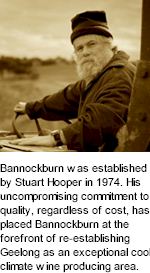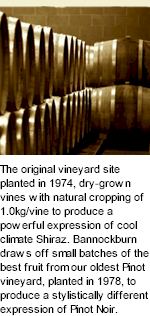


Bannockburn was established by Stuart Hooper in 1974. It was Hooper's passion to share the enjoyment of a bottle of red with friends and family, and his dream of producing wine from his own vineyard, that lead to the establishment of Bannockburn. His vision was to create a vineyard which would produce Australian wine of a quality to emulate the great wines of France, in particular the great Burgundies. Stuart had a purist, uncompromising approach to quality grape growing and winemaking. He had a strong belief in making wines which genuinely reflect the flavours of the vineyard. Although Stuart has since passed away, Bannockburn Vineyards remains in the Hooper family and his philosophy remains as the cornerstone behind all Bannockburn represents today.

All Bannockburn wines are produced from estate-grown fruit off 27 hectares of vines. Situated on 3 separate sites, the vineyard soil profile ranges from black brown volcanic loam to dense clay sitting on a limestone base, and are generally of low fertility. The first vineyard was planted in 1974 with subsequent plantings during the early 1980s, making them among the oldest in the Geelong region. Further plantings were carried out in 2007 on a high density 2 hectare block of Pinot Noir and Shiraz on a north facing slope. A state of the art winery was built in 1981 and ithe underground cellar is temperature controlled housing 400 French barriques and 6,000 cases of bottled wine.
Bannockburn Vineyards is located 25 kilometres northwest of Geelong, along the Midland Highway, just outside the township of Bannockburn. The average rainfall of 600mm. occurs mainly in winter and spring, although with the affect of the ongoing drought has been considerably lower and the rainfall is consistently much lower than neighbouring wine growing regions such as Yarra Valley and Mornington Peninsula.
The maritime influence over the weather ensures mild temperatures and long sunshine hours. It is normal to experience a pattern of stable, dry and low humidity conditions over the grape growing season from budburst in mid September through to the end of harvest in late April, thus allowing for a mild, extended ripening period and ideal conditions for producing healthy fruit and gradual flavour development in the grapes.

All the established vineyards are dry-grown, this along with poor soil fertility, low rainfall, close-plantings and strong prevailing winds make for a tough growing environment that naturally restricts yields. These are the conditions that make up the terroir from which the unique wine flavours and wine structure are derived. At Bannockburn it is the vineyards that make the wines unique and provide a true point of difference. Viticulture and winemaking aims to showcase the vineyard sites as sympathetically as possible.
The range of wines include Chardonnay, Pinot Noir, Shiraz, Riesling, Sauvignon Blanc, a dry red blend and Saignée (a dry rose style) In addition there are four celebrated single-vineyard wines: S.R.H. - using fruit sourced from the oldest Chardonnay vines at Olive Tree Hill Vineyard. Named in recognition of Bannockburn founder, Stuart Reginald Hooper. Serré - Pinot Noir grown at Serré Vineyard, using close-planting, low trellising and narrow rows to replicate the tough vineyard conditions of Grand Cru Burgundy, naturally yielding at 500g/vine. Range - the original vineyard site planted in 1974, dry-grown vines with natural cropping of 1.0kg/vine to produce a powerful expression of cool climate Shiraz. Stuart - drawing off small batches of the best fruit from our oldest Pinot vineyard, planted in 1978, to produce a stylistically different expression of Pinot Noir.
As can be seen on every bottle of Bannockburn wine, there is a bird clutching a fish in its claws. This is known as the Halcyon symbol, derived from Greek mythology, and is supposed to mean peace and plenty. A dictionary definition of Halcyon provides calm, peaceful, happy; or Halcyon days means time of peace and happiness. The symbol thus reflects the true purpose of the wine, which is to provide enjoyment to friends who find peace and happiness in each others company.
